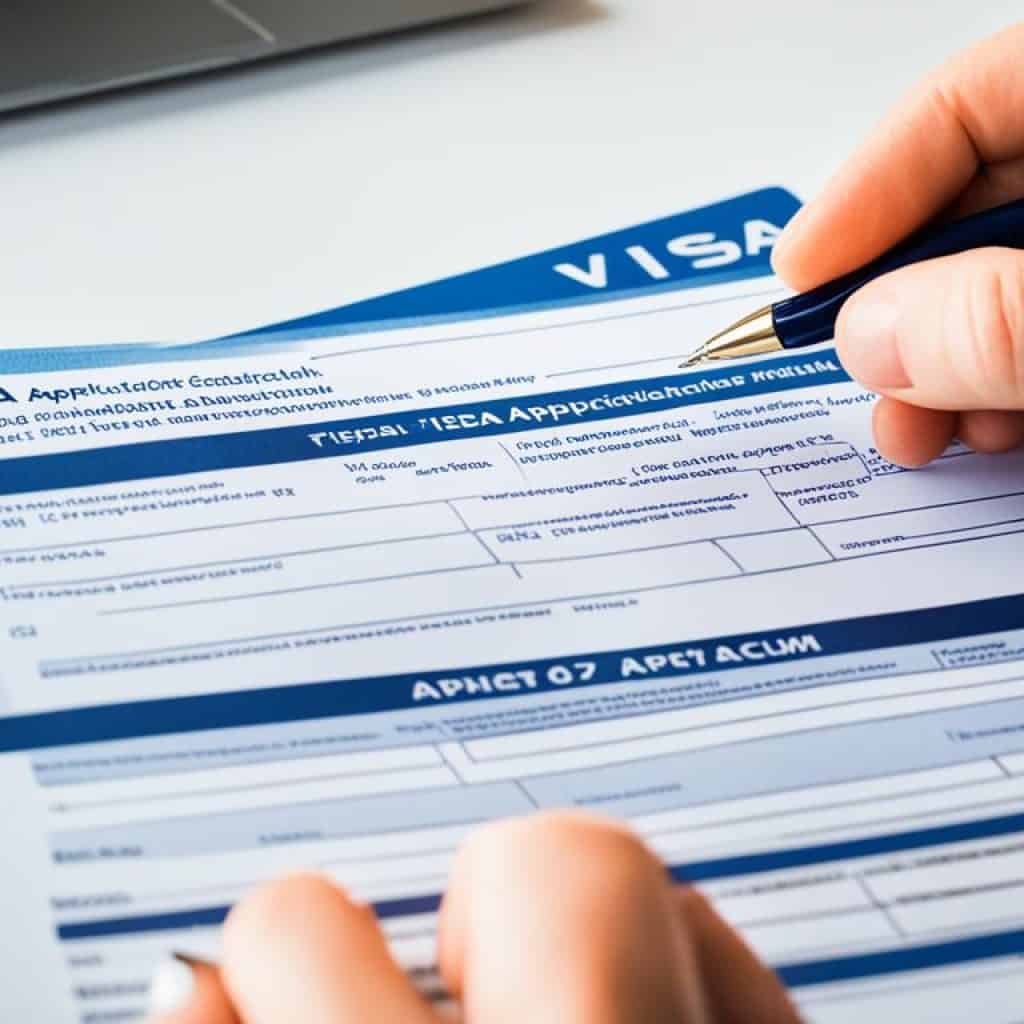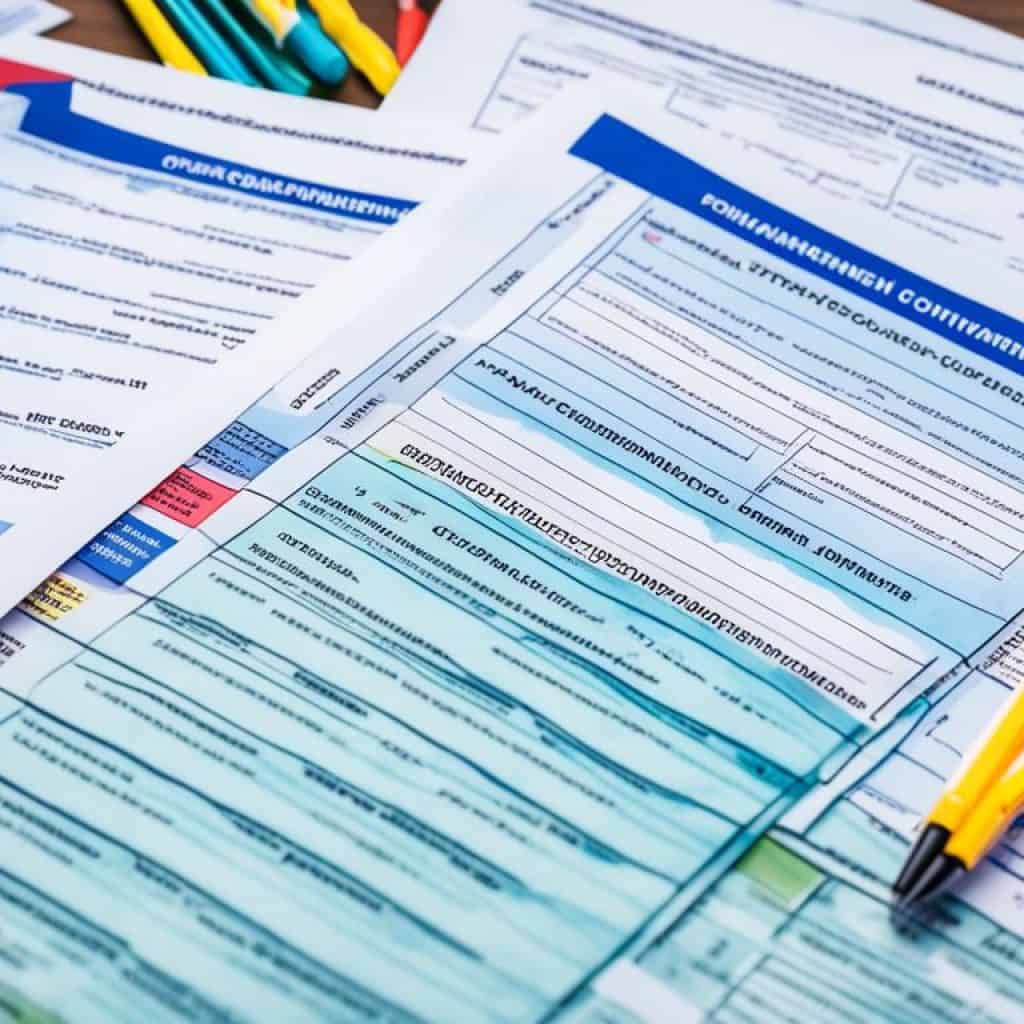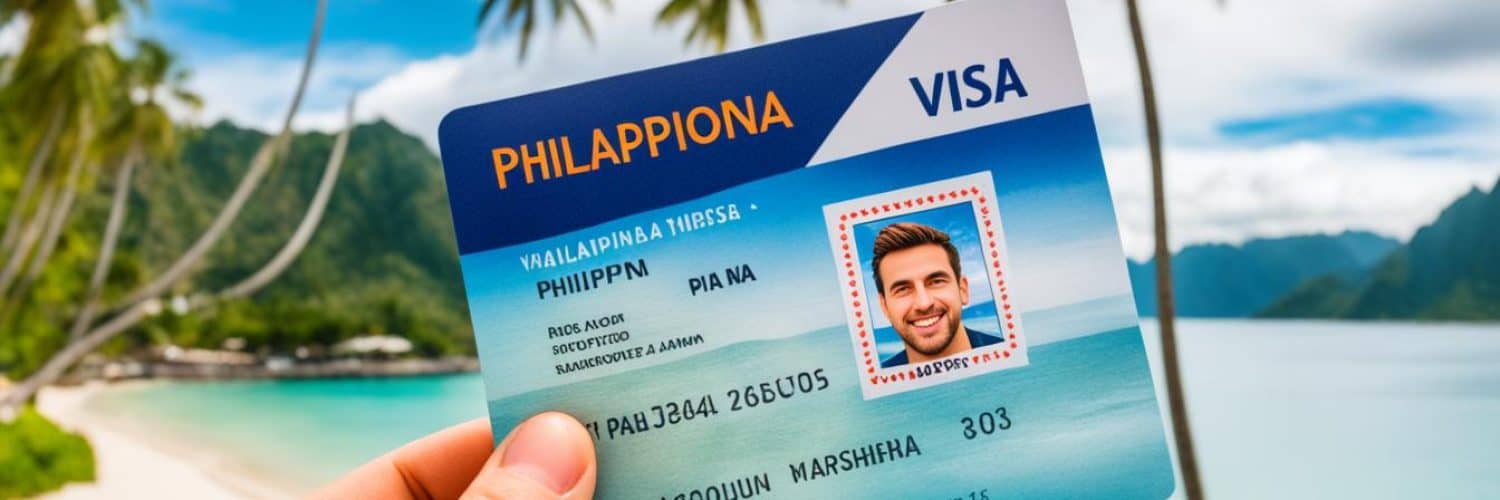Are you a U.S. citizen married to a Filipino? Are you longing for a permanent residency in the Philippines? Discover how you can unite with your Filipino spouse and gain permanent residency. We will guide you through the process and requirements to get this special visa.
Key Takeaways:
- Learn how to navigate the process of obtaining a Philippines 13A visa as a U.S. citizen.
- Understand the requirements and step-by-step instructions for applying for the 13A visa.
- Discover the benefits of the 13A visa, including the opportunity for permanent residency in the Philippines.
- Find out how to include dependent spouses and unmarried children in your visa application.
- Gain insights into additional requirements, fees, and the role of the visa officer in the application process.
Conversion to Non-Quota Immigrant Visa by Marriage (Probationary)
The 13A visa is given to foreign nationals married to Philippine citizens. It starts as a probationary visa. Later, it can turn into a permanent resident visa.
“The 13A visa lets foreign spouses live long-term in the Philippines. Through marriage, they can become permanent residents.”
This visa helps foreign spouses stay in the Philippines legally. It’s a test to see if the marriage is real. The government can check the marriage’s truthfulness.
Foreign spouses must follow certain rules during this test period. They should keep their marriage valid and live in the Philippines. After about a year, this visa can become a permanent one.
“The probation period checks if the marriage is real. It stops people from faking a marriage to live in the Philippines. It also tests the marriage’s strength.”
Requirements for Conversion to Permanent Resident Visa
After passing the probation period, you can ask to make your visa permanent.
| Requirements | Documents |
|---|---|
| 1. Valid Marriage | Marriage certificate |
| 2. Proof of Relationship | Joint bank accounts, property papers, and friend’s affidavits |
| 3. Valid Passport | Passport with a valid visa |
| 4. Biometrics | Getting your fingerprints and photo at the Bureau of Immigration |
| 5. Medical Clearance | A doctor’s health certificate |
| 6. Police Clearance | Police checks from your country and the Philippines |
There might be more papers needed, depending on your case.
After turning in these documents, the Bureau of Immigration will look at your request. If they agree, you’ll get a permanent resident visa. This visa lets you stay indefinitely and enjoy benefits like working and doing business in the Philippines.
To wrap up, the 13A visa is a way for foreign spouses to start a new life in the Philippines. From a temporary probationary visa, it can turn into a permanent one. This change lets foreign spouses enjoy living with their Filipino partners fully.
BI Main Office and Other Immigration Offices
If you’re applying for a 13A visa, there are two places you can go. You can either visit the BI Main Office or other immigration offices throughout the Philippines. Before you go, make sure to check which offices can handle your 13A visa application.
You can grab a list of what you’ll need and the application form from the Public Information and Assistance Unit (PIAU). They’re located on the ground floor of the BI Main Office, or you can visit the official BI website. The PIAU will give you the help and advice you need for your application.
Before you submit your 13A visa application, it’s smart to call the BI Main Office or your local immigration office. They’ll tell you exactly what you need to bring and how the process works. This way, you can get your documents ready early and avoid any hold-ups or problems.
BI Main Office and Immigration Offices
| Office | Location | Contact Information |
|---|---|---|
| BI Main Office | PICC Complex, Lawton Ave., Pasay City, Metro Manila | Telephone: (02) 8465-2400 |
| BI Field Offices | Various locations across the Philippines | Check with the BI Main Office or visit the official BI website for the complete list of field offices and their contact information. |
Picking a location that’s easy for you and ensuring you have everything required will let you approach the 13A visa application with confidence. The BI Main Office and other authorized offices are ready to help at each step.
Application Process
To get a 13A visa, you must follow a series of steps with great care. First, submit the needed documents for an initial check. This is to make sure you’re eligible and have all your paperwork ready.
After your documents are checked, you’ll receive a payment slip. This tells you how much you have to pay for the visa. Make sure to read the payment details carefully and pay the fees to continue.
Pro Tip: Keep in mind that fees may vary depending on the category (principal, dependent spouse, or dependent child). Stay updated with the latest fee structure to ensure you have the correct amount ready for payment.
Next, you’ll have a hearing at the Bureau of Immigration. Here you can present your case and answer any questions. It’s important to come prepared with all the necessary documents.
At the hearing, they will take a picture of you and get your fingerprints. This is a normal part of getting a visa. They use this information to check who you are during the process.
Make sure to regularly check the official website for updates on your application. This will let you know if you need to provide any more documents.
Pro Tip: As you wait for your visa application to be processed, it’s a good idea to familiarize yourself with the process of obtaining an Alien Certificate of Registration (ACR I-card). The ACR I-card serves as an identification card for foreigners residing in the Philippines. Once your 13A visa is approved, you may be eligible to apply for an ACR I-card.
When your 13A visa is approved, you must put the visa sticker in your passport. This sticker lets you enter and live in the Philippines as a permanent resident.
If you are eligible, you can also get your ACR I-card. This card is an important proof of your legal status in the Philippines. You might need it in certain situations.
| Application Process | Additional Information |
|---|---|
| Submit required documents for pre-screening | – |
| Obtain order of payment slip | Review fees and payment instructions |
| Pay necessary fees | Stay updated with the latest fee structure |
| Attend hearing | Come prepared with all relevant documents |
| Undergo image and fingerprint capturing | Standard identification procedure |
| Check official website for updates on application status | Stay informed about additional requirements |
| Submit passport for visa implementation | Granting of permanent residency rights |
| Claim ACR I-card (if applicable) | Further proof of legal status |

Documentary Requirements for Principal Applicant
To apply for a 13A visa, make sure you have all needed documents. These documents show if you’re eligible for the visa.
Here’s what you must submit:
- Completed CGAF: Fill out the Comprehensive General Application Form (CGAF) fully and accurately. It collects important info about you and your spouse.
- Official Receipt: You need to provide a receipt with your application. This shows you paid the fees through authorized channels.
- Marriage Certificate: Provide a marriage certificate or something that proves your marriage is valid.
- Proof of Financial Capacity: Show you can support yourself and your spouse in the Philippines. This might be bank statements or employment letters.
These are just the starter requirements. During the application, you might need to provide more documents. Be ready to supply any extra documents quickly to avoid delays.
Tip: Keep your documents organized and make copies for your records. This makes the process smoother and helps if you need to submit more documents.
A full and well-documented application helps your chance of getting a 13A visa. Check the list carefully to make sure you’ve included everything needed.
For more details on what’s required, visit the Bureau of Immigration website or talk to the Philippine Embassy or Consulate in the United States.
Now, we will look at the fees and process to get an ACR I-Card in the next part.
Fees for 13A Visa and ACR I-Card
Knowing the fees for a 13A visa is key. Below is a table of current fees as of [insert date].
| Category | Fee |
|---|---|
| Principal | Php 8,620.00 |
| Dependent Spouse | Php 8,620.00 |
| Dependent Child (16-21 years old) | Php 8,370.00 |
| Dependent Child (14-15 years old) | Php 7,870.00 |
An ACR I-Card fee also applies. For one-year validity, it’s US $50.
Check the Bureau of Immigration website for fee updates. Remember, visa processing fees are not refunded, so check the amounts before paying.
Now you know about the documents and fees. Next, we’ll discuss adding your spouse and children to your 13A visa application.
Inclusion of Dependent Spouse and/or Unmarried Child/ren
The 13A visa allows dependent spouses and kids under 21 to be included. This means families can live together in the Philippines as temporary residents.
To include family members, the applicant must fill out the same forms and provide similar documents. These include the General Application Form (CGAF) and documents like the marriage certificate and proof of finances.
After the 13A visa is approved, family members can get their own ACR I-card. This card is an important ID for those living temporarily in the Philippines.
Benefits of Including Dependent Spouse and Unmarried Children
Including family in the 13A visa application brings many benefits. It means having loved ones close during the stay. It makes the experience in the Philippines better for everyone.
| Benefits | Dependent Spouse | Unmarried Children |
|---|---|---|
| Legal Status | They get legal status as a dependent. | They get legal status as a dependent. |
| Ease of Travel | They can travel with the main applicant easily. | They can travel with the main applicant easily. |
| Education | Spouses can study in Philippine institutions. | Kids can join schools and universities in the Philippines. |
| Healthcare | Access to healthcare is available. | Access to healthcare is available. |
Adding family members to the 13A visa lets everyone fully benefit. It opens up many opportunities and advantages for life in the Philippines.
Fees and ACR I-Card
The 13A visa fees depend on the type you need. Here are the fees as of March 6, 2014:
| Category | Fee |
|---|---|
| Principal | Php 8,620.00 |
| Dependent Spouse | Php 8,620.00 |
| Dependent Child (16-21 years old) | Php 8,370.00 |
| Dependent Child (14-15 years old) | Php 7,870.00 |
An ACR I-card fee also applies. This card is valid for one year and costs an extra US $50.
The fees listed can change. It’s key to check the latest on the official website or with the Philippine Embassy.
Spouse of a Filipino Citizen (13) Documentary Requirements
If you’re married to a Filipino citizen and want a visa, you need certain documents. These are vital for your visa application to go smoothly. Here’s what you should collect:
- Report of Marriage: This confirms your marriage. You’ll get it from a government agency.
- Valid Passport: Make sure your passport is valid for six months from your application date. It proves who you are.
- Completed Application Form: Fill in the application form properly, providing all needed details.
- Medical Certificate: You must show a medical certificate. It proves you’re healthy for travel and living in the Philippines.
- Police Clearance: Get a police clearance from where you live. It must show you have no criminal record.
- Proof of Financial Capacity: Show proof you can support yourself, and maybe your family, in the Philippines. Bank statements or an employment contract work.
- Letter from the Filipino Spouse: A letter from your Filipino partner asking for your visa can be very helpful.
Gather and submit these key documents for your visa application as a Filipino citizen’s spouse.
Note:
It’s important to remember that required documents can change based on your situation and where you apply. For the most current information, check the website of the Philippine Embassy or Consulate.
Unmarried Children under 21 years old of a Filipino Citizen (13-a) Documentary Requirements
If you’re an unmarried child under 21 of a Filipino citizen, you might qualify for a 13A visa. You’ll need to provide specific documents along with your application. This helps complete your application.
Documentary Requirements:
- Apostilled Birth Certificate: You need to show an apostilled birth certificate. It proves who you are and your relationship to the Filipino citizen.
- Proof of Parent’s Filipino Citizenship: Make sure to include documents that show your parent is a Filipino citizen. Their Philippine passport or Certificate of Naturalization works.
- Sworn Statement of Financial Support: If you can’t show you have enough money, your parents might need to provide a financial support statement. This document proves you won’t be financially dependent on the Filipino citizen who is sponsoring you.
To improve your chances of getting a 13A visa, submit these additional documents with your application. Make sure you have all the paperwork and meet all the requirements for a good chance at approval.
“To apply for a 13A visa as an unmarried child of a Filipino citizen, you need certain documents. This includes an apostilled birth certificate, proof of your parent being a Filipino, and possibly a financial support statement.”
| Documentary Requirements for Unmarried Children of a Filipino Citizen |
|---|
| Apostilled Birth Certificate |
| Proof of Parent’s Filipino Citizenship |
| Sworn Statement of Financial Support |
Having your documents ready speeds up the 13A visa process and helps with smooth approval. Make sure to meet all requirements so your application is complete and ready to go.
Additional Documents and Visa Officer’s Discretion
The role of a visa officer is vital in assessing a 13A visa application. Sometimes, they might ask for more documents. This helps them figure out if the applicant qualifies. It’s important to have any additional visa documents ready that your application might need.
The visa officer has the power to either approve or deny a visa application. They use their judgement based on the provided documents and other facts. So, it’s key to make sure you’ve filled out your application completely and properly.
Remember, what the visa officer decides is final. They make their choices based on what the immigration laws of the Philippines say. Knowing and following this process can help you get a positive response to your application.
If the officer asks for more documents, it’s important to hand them over quickly. Showing you follow the visa rules is crucial. These extra documents let the visa officer make a clear decision about your visa eligibility.
“The visa officer has the authority to request additional visa documents to ensure the applicant meets the requirements pertaining to the 13A visa.” – Immigration Department
The documents needed might change based on your application’s details. Yet, some usual ones include:
- Proof of enough money, like bank statements or job contracts
- More proof of a real relationship, such as photos or letters
- Character references or legal statements
These extra pieces of evidence help show you qualify. They ensure your application gets a thorough review by the visa officer.
It’s crucial to submit all needed documents on time. This stops any hold-ups or problems with your application. Not sending the needed documents might mean your application gets turned down.
By realizing how important these documents are and meeting the visa officer’s requests, you can improve your chances. Doing so can help you reach your aim of joining your Filipino partner in the Philippines.

Postal Services and Responsibility of Documents
Sending your 13A visa application documents by mail is handy. For a smooth process, it’s suggested to use USPS Priority Mail. This method is both reliable and helps speed up the return of your documents.
To make the return envelope, it should be self-addressed and include prepaid postage. This lets the consulate send back your documents easily. Make sure the address is correct to avoid any delivery mistakes.
The postal service is in charge of keeping your documents safe and delivering them on time. The Philippine Consulate General isn’t responsible for any loss or delays caused by mail services. This includes the U.S. Postal Service or any courier used.
So, you should be careful when sending important documents. Choose a trusted shipping service to reduce mailing risks.
Aside from picking a postal service, make sure all required documents are gathered and packed well. Check the consulate’s list to ensure you have everything needed for your application.
By doing these things, you help secure your documents’ mailing process. This increases your chances for a smooth and trouble-free visa application experience.
Visa Requirements for Other Countries
Visa rules for visiting the Philippines can differ based on your nationality. It’s important to check with the Philippine Embassy or Consulate for current rules.
Here are some common visa rules for various countries:
| Country | Visa Requirement | Additional Conditions |
|---|---|---|
| United States | Visa not required for stays up to 30 days Visa required for longer stays |
– |
| Australia | Visa not required for stays up to 30 days Visa required for longer stays |
Must have a return ticket |
| United Kingdom | Visa not required for stays up to 30 days Visa required for longer stays |
Passport must be valid for at least 6 months |
| Canada | Visa not required for stays up to 30 days Visa required for longer stays |
– |
Remember, visa information can change. Always confirm visa rules for your country with the Philippine Embassy or Consulate. They can give you the latest on visa needs, how to apply, and other entry rules for the Philippines.
Conclusion
Getting a Philippines 13A visa means you can live there permanently. It’s perfect for U.S. citizens who want to be with their Filipino spouse. This guide has shown you how to do it, step by step.
This guide makes the visa application easy to understand. You’ll know what documents you need and what to do next. The 13A visa lets you start a new life with your partner in the beautiful Philippines.
This guide is all you need to get your Philippines 13A visa. It’s your first step to being with your loved one in the Philippines. Get ready to explore a new world together.


















Add comment